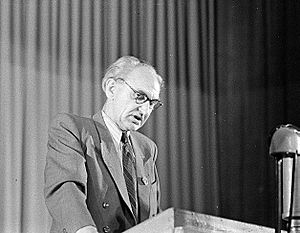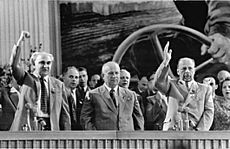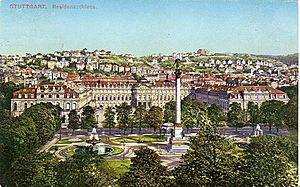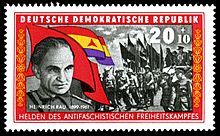Heinrich Rau facts for kids
Quick facts for kids
Heinrich Rau
|
|
|---|---|

Rau giving a speech in Leipzig, 1950
|
|
| Born |
Heinrich Gottlob Rau
2 April 1899 Feuerbach, Kingdom of Württemberg, German Empire
|
| Died | 23 March 1961 (aged 61) |
| Resting place | Zentralfriedhof Friedrichsfelde, Berlin, Germany |
| Organization | Spartacus League, International Brigades |
| Known for | Leader of the XI International Brigade Chairman of the German Economic Commission |
| Political party | Independent Social Democratic Party of Germany (1917–1919) Communist Party of Germany (1919–1946) |
| Spouse(s) | Helene Heß Elisabeth Bihr |
| Children | 3 sons, 1 daughter |
Heinrich Gottlob "Heiner" Rau (born April 2, 1899 – died March 23, 1961) was an important German politician. He was a communist leader during the Weimar Republic (Germany's government after World War I). Later, he played a big role in the International Brigades during the Spanish Civil War. After World War II, he became a top leader in East Germany.
Rau grew up near Stuttgart. He joined socialist youth groups early on. After fighting in World War I, he took part in the German Revolution of 1918–19. From 1920, he was a key person in the Communist Party of Germany (KPD), focusing on farming policies. When Adolf Hitler came to power in 1933, Rau was jailed for two years. He spent more than half of Hitler's rule in prison because he was an enemy of the Nazi government.
After his first time in prison, he moved to the Soviet Union (USSR) in 1935. From there, he went to Spain in 1937. He fought in the Spanish Civil War as a leader of one of the International Brigades. In 1939, he was arrested in France. The French government, called Vichy France, sent him back to Nazi Germany in 1942. After being held by the Gestapo (secret police), he was sent to the Mauthausen Concentration Camp in March 1943. While there, he secretly helped organize prisoners. This led to a camp uprising just before World War II ended in Europe.
After the war, Rau became very important in East German politics. Before East Germany was officially formed, he led the German Economic Commission. This was like a first government for East Germany. Later, he became the head of the National Planning Commission and a deputy leader of the East German Council of Ministers. He was a top economic politician and diplomat, leading different government departments. He was also a member of the powerful Politburo within East Germany's ruling Socialist Unity Party of Germany (SED).
Contents
Early Life and Political Start
Growing Up in Stuttgart
Childhood and First Jobs
Heinrich Rau was born in Feuerbach, which is now part of Stuttgart. His father was a farmer who later worked in a factory. Heinrich grew up in Zuffenhausen, another part of Stuttgart. After finishing school in 1913, he started working in a shoe factory. In November 1913, he moved to the Bosch factory in Feuerbach. He trained there as a metal presser and stayed until 1920. This was interrupted by his military service in World War I and the German Revolution that followed.
Joining the Labor Movement
From 1913, Rau also became active in the labor movement. This was a movement of workers trying to improve their rights and working conditions. He joined the German Metal Workers' Union and a socialist youth group. During World War I, Rau's youth group was influenced by the left wing of the Social Democratic Party of Germany (SPD). These leftists believed the war was a fight between powerful countries trying to gain more control.
In 1916, Rau joined the Spartacus League (Spartakusbund), a far-left group. He also helped start their youth organization. In 1917, he joined the Independent Social Democratic Party of Germany (USPD), a left-wing group. In 1919, he joined the Communist Party of Germany (KPD), which was mainly founded by members of the Spartacus League.
In 1917, Rau, who was a trade union official at his factory, tried to organize a strike against the war. This led to a warning from his boss. It might have also made him join the army sooner, in August 1917. He was sent to the Western Front. In September 1918, he was injured when a shell hit his lungs. He was treated in military hospitals. While recovering, he got leave and joined the revolution happening in Stuttgart on November 8, 1918.
The German Revolution
The revolution in November 1918 ended the monarchy (rule by a king) in Germany. King William II left Stuttgart on November 9. This happened after a crowd stormed his home and put up a red flag. On the same day, protesters took over some army barracks. Rau actively took part in these events in Stuttgart.
These events were the peak of unrest that started with big strikes and protests. On November 4, 1918, a "workers' council" (a group of elected workers) was formed in Stuttgart. More worker and soldier councils were formed in the following weeks. Rau was chosen to lead the military police in his hometown of Zuffenhausen.
On November 9, about 150 council members met in Stuttgart. They asked the leaders of the SPD and USPD parties to form a temporary government. A Spartacist named Albert Schreiner became the Minister of War in this new government. But he resigned quickly due to disagreements. The Spartacists wanted a revolution like the one in Russia. Other politicians supported a parliamentary democracy and early elections.
In the next few months, communists tried to take power in Stuttgart through armed rebellions and strikes. They took over public buildings. In April 1919, during a general strike, 16 people died in street fights. Rau used his position to shut down companies that kept working during the strike. But when the strike failed, he was removed from his job by the government.
Rau went back to work at Bosch. During another general strike in 1920, he led the strike committee at his factory. This led to him being fired.
Important Teachers
From 1919 to 1920, Rau led the KPD group in Zuffenhausen and then in Stuttgart. The party leader in Württemberg was Edwin Hoernle. Hoernle had visited Rau's youth group and became a close friend and teacher. He let Rau use his large library.
Another very important person in the movement was Clara Zetkin. She was a founding member of the Second International (a group of socialist and labor parties). She had lived near Stuttgart since 1891. Her house became a meeting place for important communist leaders, including Vladimir Lenin. In 1920, when Zetkin was elected to the Reichstag (German parliament) in Berlin, Hoernle and Rau also moved to Berlin.
Moving to Berlin
In November 1920, Rau became a full-time party worker. He was the secretary for farming issues in the KPD's Central Committee in Berlin. From 1921 to 1930, he gave lectures at KPD schools and edited farming magazines.
Edwin Hoernle, Rau's friend from Stuttgart, was initially the head of the Central Committee's farming division. When Hoernle moved to a higher position in 1922, Rau took over as division chief. Rau also became a leader in various national and international farmer organizations. He was a member of the International Committee of Agricultural and Forest Workers from 1923. From 1928 to 1933, he was a member of the Preußischer Landtag, the Prussian state parliament. He chaired its committee on farming.
Prison, Spanish Civil War, and World War II
After Hitler took power in January 1933, the KPD was banned. Rau became a party instructor for southwest Germany. He worked secretly to build an underground party organization. On May 23, 1933, Rau was arrested. In December 1934, he was found guilty of "preparing to commit high treason" by the People's Court. He was sentenced to two years in prison. After his release, he moved to the USSR in August 1935, going through Czechoslovakia. He became a deputy chairman at the International Agrarian Institute in Moscow.
When the Spanish Civil War started, and the International Brigades were formed, Rau went to a military school in the USSR. He then went to Spain in April 1937. He joined the XI International Brigade. From May 1937, he served as a political leader, then as chief of staff, and finally as commander of the brigade until March 1938, when he was injured.
Even though his brigade had some temporary successes, Francisco Franco's troops were winning the war. Rau's brigade fought in the battles of Brunete, Belchite, Teruel, and the Aragon Offensive, where Rau was wounded.
During this time, there were also political struggles within the communist movement, known as the Great Purge. Rau was briefly imprisoned by André Marty, a chief leader of the International Brigades. A report in 1940 called Rau a "political criminal" for having contact with Spanish anarchists and members of the Workers' Party of Marxist Unification (POUM). These were serious accusations that could lead to death sentences.
However, Rau also had powerful friends. He was released from prison and left Spain. He moved to France in May 1938. There, he led a committee for German and Austrian fighters from Spain. In early 1939, Rau went back to Spain. He and Ludwig Renn led the remaining parts of the XI Brigade. They fought to protect refugees escaping to France after Barcelona fell. This helped about 470,000 civilians and soldiers escape.
Rau was arrested by French authorities in September 1939 and sent to Camp Vernet, an internment camp. In November 1941, he was moved to a secret prison. In June 1942, the Vichy government handed him over to the Gestapo. He was held in a Gestapo prison until March 1943. Then he was sent to the Mauthausen Concentration Camp. He stayed there until May 1945. He was one of the organizers of a secret military group within the camp that led a rebellion to free the prisoners.
Life in East Germany
Starting Over (1945–1949)
New Beginnings in Brandenburg
After the war, Rau spent a few weeks in Vienna. He helped KPD representatives gather German political prisoners who had been freed. In July 1945, he led a group of 120 former Mauthausen prisoners to the Soviet-controlled part of Berlin.
In September 1945, the Soviets made Rau a leader in the Brandenburg province. He was a vice-president in charge of food, farming, and forests. He helped carry out the land reform in the province. In 1946, he became responsible for economy and transport in Brandenburg. In 1946, the eastern KPD and eastern SPD were forced to merge, forming the Socialist Unity Party of Germany (SED). Rau became a member of the SED. From 1946 to 1948, he was a state parliament member and Minister for Economic Planning for Brandenburg.
Leading the Economy
In March 1948, Rau became the head of the German Economic Commission (Deutsche Wirtschaftskommission or DWK). This organization became the main administrative body for the Soviet-controlled zone. It was the first step towards the future East German government. This was a very challenging time.
A big event was the currency reform of 1948. On June 20, 1948, the western German zones introduced a new currency. This left the eastern zone with the old money. To avoid inflation, the DWK, led by Rau, quickly introduced its own currency. The DWK also used this reform to redistribute money, using different exchange rates for private and state-run companies. The disagreement over which currency to use in Berlin led to the Berlin Blockade by the USSR. The Western powers then supplied West Berlin by air.
Under Rau's leadership, the DWK became more and more independent, working with the Soviet Military Administration in Germany (SMAD). Rau tried to make agreements that also bound the Soviet side, especially regarding confiscations for war reparations. A major success was a half-year plan for economic development in 1948, which the SMAD accepted. This was followed by a two-year plan for 1949 and 1950.
The biggest problem for these plans was the Berlin Blockade. The eastern zone relied heavily on supplies from the West, so the blockade hurt the East more. Rau openly criticized the blockade in a meeting, saying that Soviet help was not enough. The Berlin Blockade was finally lifted on May 12, 1949.
The DWK grew a lot under Rau, from about 5,000 employees in mid-1948 to 10,000 by early 1949. In March 1949, Rau signed the first trade agreement with a foreign country, Poland, acting like a head of state.
Building a New State (1949–1953)
Founding East Germany
Rau's time leading the German Economic Commission ended in October 1949. This was when the East German state, the German Democratic Republic (GDR), was founded. The GDR was officially announced on October 7, 1949. Five days later, the DWK was formally closed. Rau then became a member of the People's Chamber, the new East German parliament, and joined the new government.

In 1949, the ruling SED party set up its leadership structure. Rau became a member of the new Central Committee of the SED and a candidate member of its Politburo. In 1950, he became a full member of the Politburo and a deputy chairman of the East German Council of Ministers.
From 1949 to 1950, Rau was the Minister for Planning of the GDR. From 1950 to 1952, he was the head of the National Planning Commission. In this important role for economic development, Rau disagreed with SED leader Walter Ulbricht. Rau blamed Ulbricht's policies for economic problems. East Germany's old president Wilhelm Pieck even brought up old accusations against Rau. In a letter, Rau complained that his speeches on economic matters were being censored.
From 1952 to 1953, Rau led a new office for Industry and Traffic. This office was created to better control the economy and fix problems caused by too much bureaucracy.
Political Changes and the Uprising
After Joseph Stalin died in March 1953, the new Soviet leaders wanted changes in East Germany. They thought about replacing Walter Ulbricht with Rau. Rudolf Herrnstadt, a Politburo member, worked with Rau to create a plan for a "New Course" in East Germany. However, a workers' uprising on June 17, which the Soviet army stopped, changed things.
Three weeks later, on July 8, 1953, Rau suggested that Ulbricht should be replaced during a Politburo meeting. Most members were against Ulbricht. But there was no clear person to replace him right away. Both Rudolf Herrnstadt and Heinrich Rau were hesitant. So, the decision was put off. The next day, Ulbricht flew to Moscow. The Soviet leaders decided to keep Ulbricht in power. After this, five members of the Politburo lost their positions.
Later Years (1953–1961)
Economic Leadership and Reform

Unlike some other leaders who were removed, Rau kept most of his jobs. He remained a member of the Politburo and a deputy chairman of the Council of Ministers. He continued to be in charge of industry for the GDR. However, his power was reduced. Bruno Leuschner, a supporter of Ulbricht, became a new Politburo member and gradually took over as the main leader for the economy. Publicly, the East German press always showed Rau and Leuschner working together well.
Rau focused on his tasks and avoided showing any public disagreement with Ulbricht. In 1954, he received a high award, the Order of Merit for the Fatherland in gold. Ulbricht later said that only three people were deeply involved in East Germany's economic development at that time: Heinrich Rau, Bruno Leuschner, and himself.
From 1953 to 1955, Rau led the new Ministry for Machine Construction. His deputy was Erich Apel, who later helped create an economic reform called the New Economic System (NES) in the 1960s. This later reform was similar to a reform in the mid-1950s. Rau's ministry had a study done in 1953 about making factories more efficient. The study suggested giving more responsibility to the factories themselves, rather than having everything controlled by the National Planning Commission. Rau supported this idea in 1954, but the planning chief Bruno Leuschner opposed it. Eventually, Ulbricht approved the policy, and the reform started in 1954. It sped up until 1956. However, it ended early in 1957 due to political unrest in other Eastern Bloc countries, like Hungary. This made leaders want more central control again. But poor economic results later led to the idea of a new planning reform, the NES, in the 1960s.
Foreign Trade and Diplomacy

From 1955 to 1961, Rau was the Minister for Foreign Trade and Inter-German Trade. "Inter-German Trade" meant trade with West Germany. At this time, both German states still wanted to reunite, but with different political systems. West Germany believed it was the only true representative for all German people. Because of this, East Germany could only have official diplomatic ties with other Eastern Bloc countries. Most other countries did not recognize East Germany.
So, Rau's ministry set up many "trade missions" in other countries. These acted like unofficial embassies. Because of his role, Rau also led the Foreign Policy Commission of the SED Politburo from 1955. This was the real decision-making body for foreign affairs. He traveled to many countries around the world. He visited core Eastern Bloc countries like China and Albania. He also visited leading countries of the Non-Aligned Movement (countries that didn't side with either the US or the Soviet Union), such as India and Yugoslavia. Between 1955 and 1957, he visited several Arab states, including Egypt, to promote diplomatic ties. One of his last agreements as minister was a trade deal with Cuba. He signed it with Cuba's minister, Che Guevara, on December 17, 1960, in East Berlin.
Heinrich Rau was in poor health in his final years. He died of a heart attack in East Berlin in March 1961.
After His Death
After Rau's death, many things were named after him, including factories, schools, vacation homes, streets, and even a fighter squadron. East Germany issued stamps with his picture three times.
Rau was married twice and had three sons and one daughter. Like other Politburo members, he lived in a special secured area of East Berlin until 1960. In 1960, he moved to the Waldsiedlung near Wandlitz. In 1963, Rau's widow, Elisabeth, moved back to their old street in Berlin.
When Johannes Rau, a well-known West German politician who later became President of Germany, visited East Germany, he was mistakenly introduced as "Prime Minister 'Heinrich Rau'". Johannes Rau joked about this, saying that Heinrich Rau was a "Minister of Trade, a Swabian, and a communist," and he was none of those things.
See also
 In Spanish: Heinrich Rau para niños
In Spanish: Heinrich Rau para niños
- International Brigades order of battle
- East German mark
- Hallstein Doctrine
- History of East Germany
- Medal for Fighters Against Fascism





